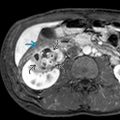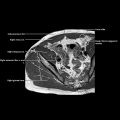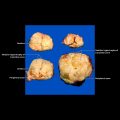KEY FACTS
Terminology
- •
Cryptorchidism, cryptorchism
- •
Definition: Incomplete descent of testis into base of scrotum
Imaging
- •
Unilateral or bilateral absence of testis in scrotum
- •
Located anywhere from kidney to inguinal canal, inguinal canal most common (80%)
- ○
Bilateral in 10%
- ○
- •
Ultrasound features: Ovoid homogeneous, hypoechoic, well-circumscribed structure smaller than normal descended testis
- •
MR: Useful for detecting intraabdominal testis, if not seen by ultrasound
Top Differential Diagnoses
- •
Inguinal lymphadenopathy
- •
Inguinal hernia
- •
Anorchia: Absent testis
Pathology
- •
Undescended testis: Arrest of testis along normal path of descent
- •
Ectopic testis: Testis outside normal path of descent
Clinical Issues
- •
Complications: Increased risk of testicular cancer (1:1,000-1:2,500), torsion, atrophy, infertility, and trauma
- •
Treatment
- ○
Orchiopexy before age 2 to preserve fertility
- ○
Orchiectomy: Consider in patients aged 12-50 years
- ○
Scanning Tips
- •
Start in high scrotal location and ask patient if palpable mass is present in inguinal region (most common location)
- •
If still not found: (1) Follow spermatic cord upward: (2) Next, using transverse approach, check lower abdominal region near groin, iliac fossa, and pelvis and in abdominal region near kidneys
 at a high scrotal location due to incomplete descent. An undescended testis may be located anywhere from the kidney to the inguinal canal.
at a high scrotal location due to incomplete descent. An undescended testis may be located anywhere from the kidney to the inguinal canal.
 , internal inguinal ring
, internal inguinal ring  , in the inguinal canal
, in the inguinal canal  , or at the external inguinal ring
, or at the external inguinal ring  .
.
 within the inguinal canal.
within the inguinal canal.
Stay updated, free articles. Join our Telegram channel

Full access? Get Clinical Tree








